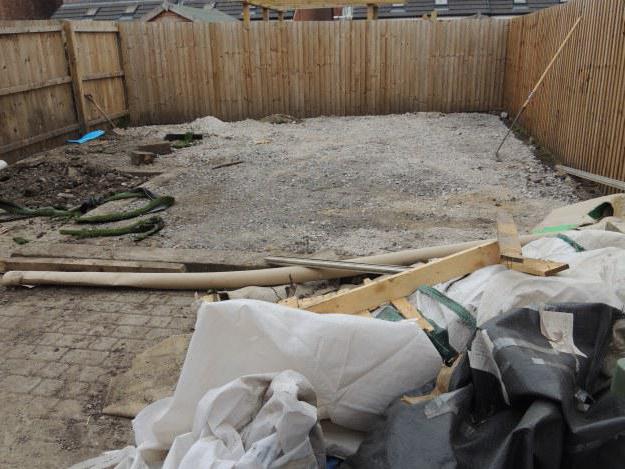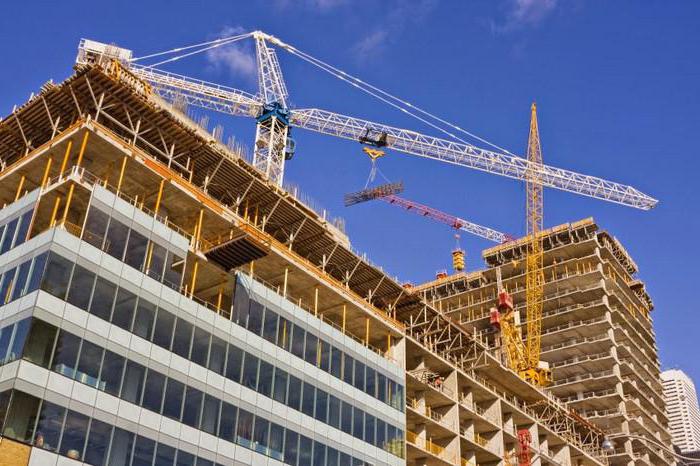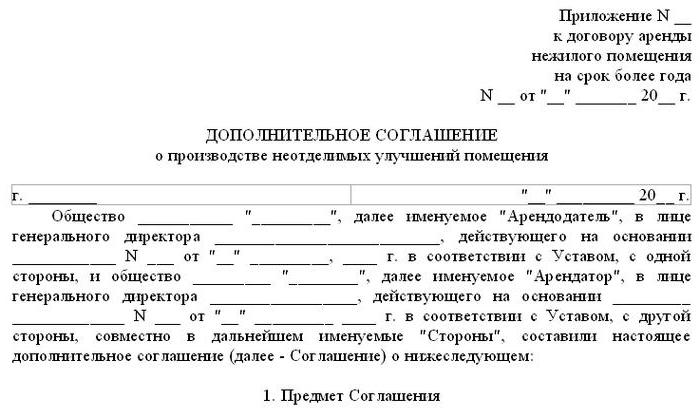When renting premises, especially if it is long-term, entities using the space often make investments in these fixed assets. This is done to bring the object into a state in which it will most fully correspond to the specifics of economic activity and the needs of the person. Often in such situations inseparable improvements occur. Leasing, as a legal relationship, is peculiar to features. In particular, the object in which the person invests does not belong to him by right of ownership. Meanwhile, the inseparable improvements of the tenant pass into its legal possession. However, a different condition may be established by agreement between the parties. Let us consider in more detail what inseparable improvements of a leased object can be. 
General information
Inseparable improvements are qualitative changes that add value to an asset. They can be aimed at:
- improvement;
- improvement of properties and technical characteristics;
- expanding the range of functionality, etc.
It should be borne in mind that the object does not acquire any new qualities during repair. Its technical characteristics do not improve either. In this regard, repair work cannot be considered as inseparable improvements to the leased property. They may recognize actions such as:
- additional equipment;
- completion;
- reconstruction;
- modernization;
- technical re-equipment.
Inseparable improvements are those changes that cannot be removed or dismantled without damaging the property.
Cost recovery
Inseparable improvements to the leased property are carried out at the expense of the entity using it under the terms of the agreement with the owner. After the termination of his action, a person has the right to rely on reimbursement of expenses. However, the law provides for a number of conditions for compensation. Thus, the landlord reimburses the costs of inseparable improvements only if the changes were made with his consent. A different condition may be prescribed by law. Inseparable property improvements made through depreciation charges from him, act as the property of the legal owner of the object. 
Possible difficulties
Before making an inseparable improvement, it is necessary to study the terms of the agreement. The document may not determine the procedure for their implementation or may establish the need to obtain the written consent of the owner. Accordingly, the subject should contact the legal owner of the facility before making inseparable improvements (a model of an additional agreement is presented in the article). However, there are situations where written consent is not possible. This problem occurs when federal property is leased. Along with this, the user needs to make certain changes to the object for normal operation. Depending on whether the expenses will be reimbursed and whether the consent of the owner will be obtained, the user enterprise will choose the option of accounting for expenses. Consider several situations.
Changes with the consent of the owner with compensation
According to paragraph 1 of Art. 256 Tax Code, qualitatively changes made with the permission of the legal owner of the object with subsequent compensation for the costs of them, are considered depreciated fixed assets. Accounting for inseparable improvements in this case is carried out in accordance with paragraph 1 of Art. 258 Tax Code. Capital investments, the cost of which is compensated to the user by the owner, are amortized by the latter. In accordance with paragraph 4 of Art.623 Civil Code, the tenant will not have any rights to these improvements. According to the Ministry of Finance, the user’s costs related to the qualitative changes of the facility, when reimbursed by the owner, appear as expenses incurred in the course of the work for the rightful owner. If inseparable improvement is carried out with the consent of the second party, then this should be documented. In particular, this condition is prescribed in the original agreement or in the annex to it. At the same time, if the owner compensates the expenses incurred by the user, then the costs can be taken into account by the lessee as the costs arising from the work for the rightful owner when calculating income tax. Moreover, the costs must comply with the requirements of paragraph 1 of Art. 252 Tax Code. 
Important point
In reporting, the time will be significant when the transition / transfer of inseparable improvements occurs. Explanations are given in the order of the Ministry of Finance No. 91n of October 13, 2003. In paragraph 35 of this document it is indicated that if in accordance with the agreement capital investments the user is transferred to the owner, the costs of the finished work, subject to reimbursement, should be deducted from the account for investments in non-current assets. In this case, the settlement article is debited. But if the contract of inseparable improvements provides for their transfer to the owner of the object with compensation for the residual value to the user who made them, the capital investments are attributed to the OS of the legal owner until the expiration of the agreement.
Changes to the property with permission without compensation
Capital investments in rental facilities in the form of inseparable improvements made with the consent of the owner are considered depreciable. This position is established in paragraph 1 of Art. 256 Tax Code. In paragraph 1 of Art. 258 of the Code stipulates that capital investments made with the permission of the owner, the value of which is not compensated by him, are amortized by the entity that made an inseparable improvement. This is done for the duration of the agreement. Amortization amounts determined based on the useful life are taken into account. It is installed for the OS or capital investments in them by classification of fixed assets approved by the government. Depreciation is charged on the first day of the month following the period in which the inseparable improvement is put into operation.
Nuances
According to paragraph 5 PBU 6/01, fixed assets include capital investments in leased fixed assets. The Methodological Instructions in paragraph 35 says that if, under the agreement, they act as the property of the legal owner of the object, the costs of completed work are debited from the loan account for investments in non-current assets. At the same time, the accounting item for the OS is debited. For the amount of costs, the user opens a separate inventory card for each object. 
Changes without the consent of the owner
The legislation does not explicitly prohibit inseparable improvements without the permission of the lessor. Meanwhile, the user must understand that in the case of the implementation of qualitative changes, the owner is unlikely to reimburse the costs. In addition, in accordance with the provisions of Article 622 of the Civil Code, in the event of termination of the agreement, the person is obliged to return the object to its rightful owner the same as he received it, taking into account the normal degree of wear or in the condition agreed by the parties. From this it follows that the owner has the right to demand that the subject bring the premises to its original form. This will entail certain costs. If the company at the same time wants to accept the specified expenses when calculating income tax, serious fiscal risks may arise. They are due to the provisions of paragraph 1 of Art. 256 Tax Code. According to the norm, only those investments in leased fixed assets that are made with the permission of the owner can act as depreciable property.It follows that the user payers, who produced them without the consent of the rightful owner, have no reason to recognize costs for the purpose of taxation on profits.
VAT Risks
They also follow from the provisions of paragraph 1 of Art. 256 Tax Code. If the costs of inseparable improvement are not taken into account when calculating the tax, then it will be very problematic to prove that they were carried out to perform operations recognized as objects of VAT. Despite the fact that these deductions do not have a direct legislative connection with each other, control bodies closely monitor compliance with the procedure for their calculation. Therefore, in the above situation, with a high degree of probability, VAT will not be deductible. Even if the payer is ready to defend his position in court, there is no guarantee that his applications will be satisfied - the authorities, as a rule, take the side of the control bodies.
Possible way out
Given the above, the following approach can be considered the least risky:
- The costs of inseparable improvements for income tax purposes are not taken into account.
- VAT deductible is not accepted.
In this case, it should be remembered that sub. 1 p. 1 Article 146 of the Tax Code, as an object of tax on ext. the cost is the transfer on the territory of Russia of products (performance of work, provision of services) for own needs, the costs of which are not included in the calculation (including through depreciation) in determining the income tax. In other words, if property improvements are made on its own and the costs are not taken into account, then the payer calculates and pays VAT on the cost of the work performed by him. Accordingly, the tax on ext. the value can be taken deductible. As a result, the amount of deductions to the budget will be reduced. 
Key conditions
Since PBU 6/01 does not establish any restrictions, qualitative changes in leased property are included in the OS if:
- The object will be used in the production of goods, the performance of work or the provision of services, for the provision of the enterprise for temporary use / ownership for a fee or management needs.
- Subsequent resale of these property values is not anticipated.
- An object may bring economic benefits to the enterprise in the future.
The cost of this property, as well as its own fixed assets, is repaid by depreciation on paragraph 17 of PBU 6/01. The term can be set in accordance with the period of the lease. It is defined in paragraph 20 of these PBUs. If at the end of the term of the agreement the inseparable improvement is transferred to the owner without compensation by the latter for the costs of it, then this can be considered as a gratuitous receipt.
Ministry of Finance clarifications
In the letter No. 03-07-05 / 29 of July 26, 2012, it was determined that, under paragraph 1 of Article 146 of the Tax Code, operations to carry out work on the territory of Russia, including free of charge, act as an object of VAT. If previously on inseparable improvements add. the value for deduction was not accepted (for example, when they are carried out without the permission of the owner), when credited from a gratuitous transfer, it can be entered into the calculation and the amount of tax payable will be reduced.
Deductions from property
This tax is paid by the entity that made the inseparable improvement when it is taken to the balance sheet as an asset. Clarifications on this issue are given in the letter of the Ministry of Finance No. 03-03-06 / 1/651 of December 13, 2012. Under paragraph 1 of Art. 374 of the Tax Code, the objects of taxation for Russian enterprises are real estate and movable property, including those provided for temporary use, disposal, possession, trust management, entered into general activities or obtained in accordance with a concession agreement, which is included in the balance sheet as fixed assets in accordance with the procedure provided for maintaining financial statements, unless otherwise specified by articles 378 and 378.1 of the Tax Code.
The rules by which OS data are generated are established in PBU 6/01 and in the guidelines that apply in part that does not contradict PBU. Under paragraph 5 of the latter, fixed assets include capital investments in leased fixed assets. According to paragraph29, the cost of retiring or incapable of making a profit to the entity should be deducted. In accordance with the provisions of PBU 6/01, capital investments in leased fixed assets are taken into account until their disposal. The latter should be understood, inter alia, as reimbursement by the owner of the cost of the improvements made by the tenant. The exception is cases when the rightful owner compensates the costs incurred by the user by establishing the appropriate amount of the facility maintenance fee. 
Postings
According to the chart of accounts, information about objects that the company subsequently accepts as an operating system, including capital construction costs, are summarized in c. 08. The initial cost of investments in leased fixed assets put into operation and executed in accordance with the established procedure shall be debited from the account. 08. She is transferred to DB SCH. 01. Thus, capital investments in a leased object as a cost of its improvements are attributed by the user to fixed assets until the objects are disposed of as part of the agreement and are subject to property tax. A different procedure is provided for the case when the owner reimburses the expenses in full. In such a situation, capital investments made by the user, reimbursed by the legal owner before they are put into operation, are not included in the OS and are not taxed.
Inseparable improvements in the sale of an apartment
Currently, most experts note an active transition of banks to a special scheme of working with clients. In particular, there is a system in which the amount of a purchase and sale transaction is reduced to 1 million p. This situation is caused by increasing competition in the housing market. Banks provide mortgages up to 1 million rubles, and the remaining part of the necessary funds is made out as a consumer loan. However, the conditions for granting both loans are the same. Some financial organizations, realizing that such lending carries certain risks, increase the interest rate on loans by 1-1.5 points. However, the volume of a mortgage transaction cannot always be reduced to 1 million rubles in all cases. For example, this is not possible with today's fairly widespread lending system using subsidies from the state.
In this case, the question arises of payment by the seller of income tax. There are several ways out of this situation. So, for example, experts explain that if the acquirer is interested in indicating the entire market value of the object, then an option is possible in which he compensates the seller for the amount of income tax. In practice, there have also been cases where the parties to the transaction agree with each other to share the costs of paying deductions among themselves. But, as experts say, such a scheme is rarely used. Previously, it was used in conditions of stagnation, when there were not so many buyers, and sellers were more loyal. During the period of market recovery, tax compensation is carried out by the interested party. If it is beneficial for the acquirer that the real value of the object is indicated, but not for the seller, then the refund is made first.  In some cases, the property owner is interested in indicating the full price. For example, this happens when he goes abroad and he needs to legalize profits. Notarial costs for paperwork when indicating the entire market value of an immovable object increase. If the acquirer does not want to overpay anything, then the seller can take on these costs. As a rule, the owner draws up two receipts. In the first, he indicates the cost by agreement with the acquirer. Another receipt shows the remaining price of the property. At the same time, he receives the amount, for example, for "preemptive right to purchase" or "inseparable home improvements." Meanwhile, a number of experts draw attention to an important fact.
In some cases, the property owner is interested in indicating the full price. For example, this happens when he goes abroad and he needs to legalize profits. Notarial costs for paperwork when indicating the entire market value of an immovable object increase. If the acquirer does not want to overpay anything, then the seller can take on these costs. As a rule, the owner draws up two receipts. In the first, he indicates the cost by agreement with the acquirer. Another receipt shows the remaining price of the property. At the same time, he receives the amount, for example, for "preemptive right to purchase" or "inseparable home improvements." Meanwhile, a number of experts draw attention to an important fact.
The amount that exceeds the non-taxable limit of 1 million rubles, which the owner, as a rule, wants to receive for “repair”, “inseparable improvement”, provision of “right to purchase” and so on, also acts as income. According to some experts, it does not matter where the subject came from - when selling a property or furniture. In any case, this is income. According to the law, it is also necessary to make mandatory deductions in the form of income tax. The difference is only in the size of the tax-free base. In this case, it will amount to 250 thousand rubles. Nevertheless, this option is not suitable for tax evasion. Moreover, the courts in such cases usually take the position of the regulatory body, and not the subject.



